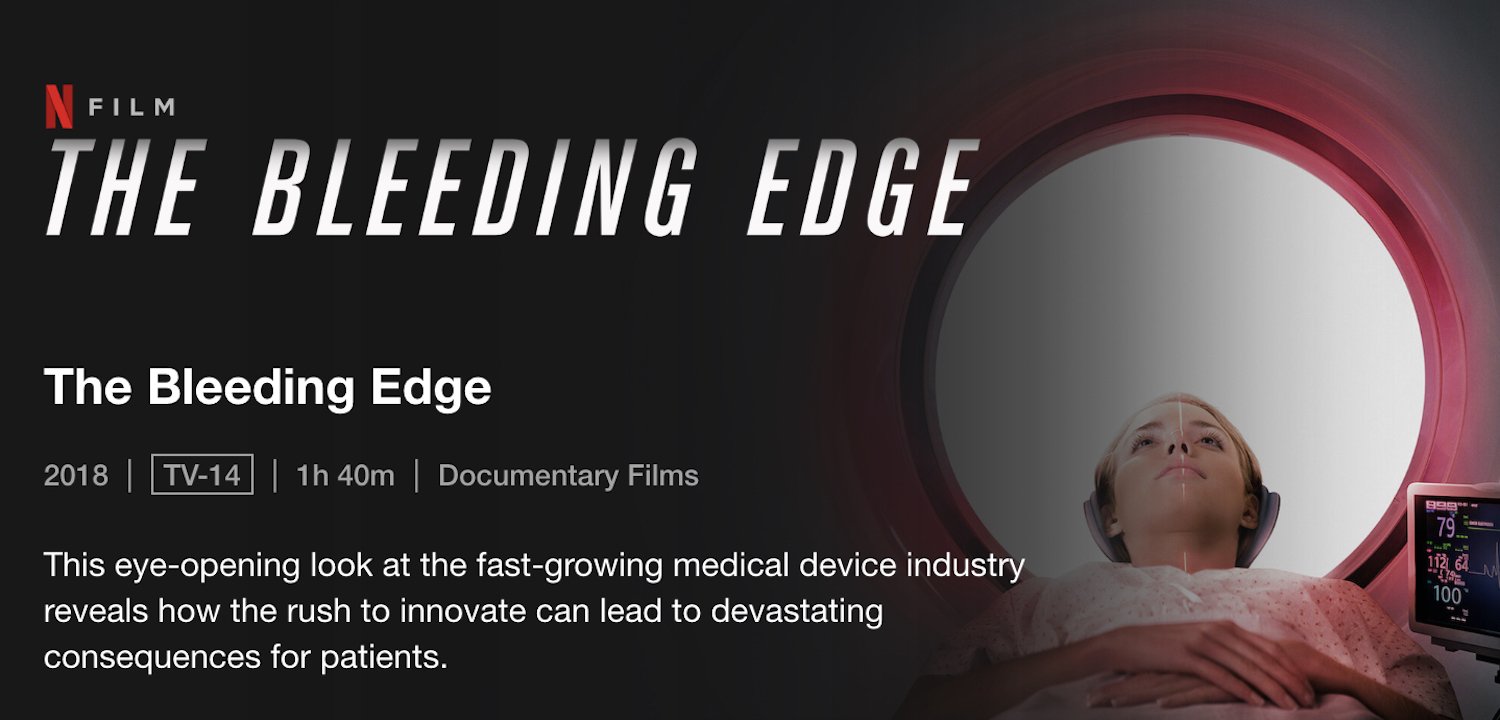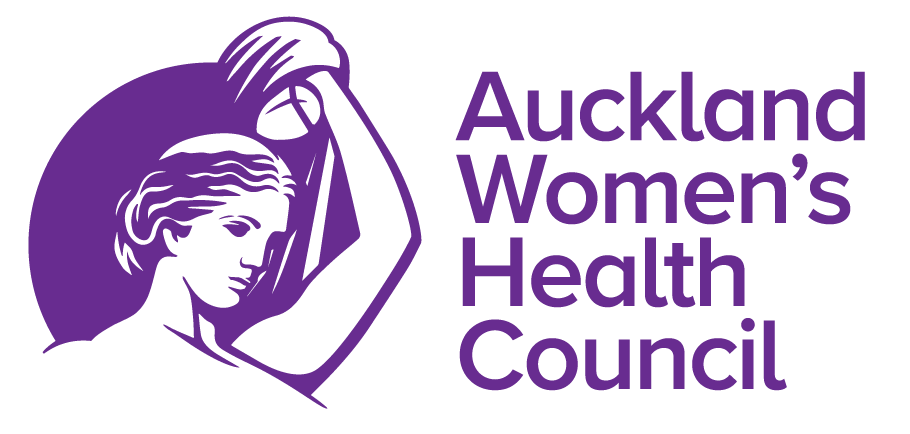Review of The Bleeding Edge

Review by Sue Claridge
The Bleeding Edge is described by Netflix as an “eye-opening look at the fast-growing medical device industry [that] reveals how the rush to innovate can lead to devastating consequences for patients”. It is a ‘must-see’ documentary for many health practitioners, including surgeons, and GPs who are inevitably the health practitioners that patients see first when they suffer life-changing harm from medical devices. But most of all, this documentary should be compulsory viewing for our health and medical regulators, and the heads of our health entities, such as the Ministry of Health | Manatū Hauora, Medsafe, ACC and HDC.
Medical devices are a 400 billion-a-year industry and, make no mistake, their primary purpose is to make money for their investors.
Despite being five years old, this documentary is still as pertinent as the day it was released. While some of the medical devices that feature are no longer on the market, that they were ever licenced and unleashed on unsuspecting and trusting health consumers is an indictment on the regulatory process for implantable medical devices, and an important warning for the future.
In one review[1], The Bleeding Edge is described as “like an all-too-real horror show that is ongoing for thousands of unwitting patients with meagre relief in sight”. I couldn’t agree more; it is a hard watch at times for anyone who possesses an ounce of empathy.
“Medical devices are a way of life in America. They are a way of life in post-industrial society. They are a reason, in some ways, for post-industrial society. They help us live longer. They give us better quality of life. And they’re just about everywhere.”
— Jim Spencer, Journalist, Minneapolis Star Tribune
Right from the beginning, the documentary is clear that many medical devices save the lives of many people and significantly improve quality of life of many, many more. But these positives must not outweigh the abject misery and harm inflicted upon thousands of people because greedy, profit-driven pharmaceutical companies and device manufacturers have taken advantage of a regulatory system that is criminally inadequate.
The Bleeding Edge features the devastating consequences of the use of metal-on-metal chrome cobalt hip replacements, surgical mesh and the Da Vinci surgical robot, particularly when used to perform hysterectomies. However, it is the focus on the Essure contraceptive device that is the most chilling, following patients who had been literally conned into having the device implanted and lied to about its benefits, on a downward spiral from health to hell on earth.
The personal stories – not just the Essure stories – are horrific and the impact on people’s lives soul-destroying; the victims of the industry’s callous disregard for the health consumers are predominantly women, whose lives have been ruined by implantable medical devices that should never have been licenced.
One of the worst of these stories is that of Ana Fuentes, a full-time married account executive with four daughters. Ana and her husband decided that four children was enough and her doctor recommended the Essure contraceptive device.
Immediately after the procedure Ana started suffering from pain and heavy bleeding, and almost immediately the gaslighting began, with her doctor telling her that Essure was nothing to do with her symptoms. She went on to needing multiple hospital visits for extreme pain and the uncontrollable menstrual bleeding.
She experienced a cascade of loss: loss of her sex life, her marriage, her job because the pain and repeated hospital visits prevented her from working; loss of income, her home, her independence and dignity. Eventually, having moved from place to place, including having to live with her children in cheap motels, Ana is forced to leave her children with a church affiliated foster family while she continued to struggle with ill-health caused by Essure.
Another very revealing story is that of Gaby Avina, a nurse who assisted with the placement of Essure during the clinical trials, who was convinced by that it was “it was everything I was looking for” in a permanent contraceptive.
“The company liked my story because I was a nurse, I’d participated on both ends of the product. So, I was invited to be a spokesperson. I even went so far as I had my own website called Ask Gaby. Patients would to me, doctors would write to me. I told them all the benefits. I used to tell them that it took longer to get your nails done than it did to get sterilized.”
Only, Gaby discovered that she had been lied to like so many others. After her procedure she was tired all the time. Then she started falling; her legs would give out. The doctor told her it was an immune response to something.
She was contacted on Facebook by many women who asked her if she was the Gabriella Avina that was the spokesperson for Essure. They asked her how her health was, and all of a sudden it all made sense to her.
Gaby says:
“I failed thousands of women for seven years. It’s a long time to tell women that a product is great. So, the guilt that you live with… and the pain… and just crazy feelings of responsibility because of that.”
At the end, the documentary makers had this advice for health consumers:
- Research any device that will be used on or in you. New is not necessarily better.
- Get a second opinion for any risky or expensive procedure.
- Ask your surgeon how many procedures he or she has performed.
- Have a friend or family member be your advocate while you’re in the hospital.
It is impossible to do justice to The Bleeding Edge in a review. It is impossible to adequately convey the horror and the trauma that so many people have experienced as a result of grossly inadequately regulated medical devices. It is impossible to convey the sense of incredulity and injustice that you feel watching this and hearing from the enormous cast of commentators, surgeons and other health professionals, academics, patients, patient advocates, regulators and FDA officials, and pharmaceutical and manufacturing staff and CEOs.
For that reason, I strongly recommend watching The Bleeding Edge if you have access to Netflix*. However, this recommendation comes with a warning: much of the content could be triggering, especially if you have been harmed by any of these devices specifically or harmed within the health system in other ways.
[1] Susan Wloszczyna: The Bleeding Edge, Reviews, RogerEbert.com, July 27, 2018.
Medical Device Regulation in the US
How is it that these defective, incredibly harmful medical devices even get beyond the prototype and clinical trial stage? The Bleeding Edge clearly sets out one of the major issues in the regulation of medical devices.
Jeanne Lenzer, author of The Danger Within Us provides some early history to regulation of medical devices:
“For many years, devices just came onto the market with the anecdotes of doctors who used them, who would say, “Well, I think it works.” It was only with the Medical Device Amendments of 1976 that devices came under control of FDA.”
“At that point, industry argued, “We don’t want to have to test everything we’re already using, pacemakers and other devices.” And the FDA said, “Okay, you can grandfather in anything that was on the market prior to 1976.”
Dr Michael Carome, Director of the Public Citizen Health Research Group, continued the story:
“Since 1976, the complexity of devices, the number of devices, the types of devices, just rapidly expanded. So, we have the same framework that was imposed, you know, 40 years ago for a device world that is much more complicated today.”
Dr David Kessler, FDA Commissioner from 1990-1997, admitted that “when it comes to medical devices, we built a system that doesn’t work.”
Because the medical device industry complained that the testing that drugs must go through to prove safety and efficacy is too expensive for the “innovation” that happens in developing medical devices, the US Congress established the 510(K) process. It allows a medical device to be approved on the basis of being substantially equivalent to a previous medical device – or predicate – that was approved.
The 510(K) process was “meant as an exception, in essence, a little loophole… That exception became the rule. So, the vast majority of devices today, regrettably, are regulated under this framework,” said Dr Kessler.
Dr Deborah Cohen, Associate Editor of the BMJ, explained that this results in “what we call a daisy chain. And then, quite often what you found is that some of these predicate devices, as they call them… have been actually recalled from the market because they’ve been failing.”
“So even if the device was recalled because it was dangerous, you can still use it as a predicate and get your device cleared because it’s substantially equivalent. So, there’s a lot of problems with that 510(K) system. And that’s how metal-on-metal hips got on the market,” explained Dr Rita Redberg, Editor of JAMA Internal Medicine.
All vaginal mesh devices were cleared through the 510(K) pathway. The FDA did not require human studies.[1]
Even the supposedly more stringent PMA or pre-market approval process for the riskiest devices is not very rigorous and is far less rigorous than the process for drugs.
“Most drugs had to have two clinical trials, and they have to have large numbers of patients. With devices, it’s only one study. Those studies are often small. Sometimes it’s 100 people. I’ve seen studies with 50 people. So, the approval process for the riskiest devices is not good,” said Dr Diana Zuckerman, President of the National Center for Health Research.
What the documentary doesn’t say, is how much other countries rely on regulation and approval of medical devices in the US, for example New Zealand. In this country, we substantially accept devices here based on approval by the FDA. In Aotearoa New Zealand, Medsafe only carries out the bare minimum of evaluation of medical devices. The only requirement is that the manufacturer or importer list it electronically on Medsafe’s WAND database within 30 days of it being first supplied. The Medicines Act contains no pre-market requirements for their assessment and approval whatsoever. Medsafe does not review any clinical or other information about a device, such as warnings or adverse event reports.
[1] Heneghan CJ, et al., 2017: Trials of transvaginal mesh devices for pelvic organ prolapse: a systematic database review of the US FDA approval process, BMJ Open, 2017 Dec 6;7(12):e017125.
